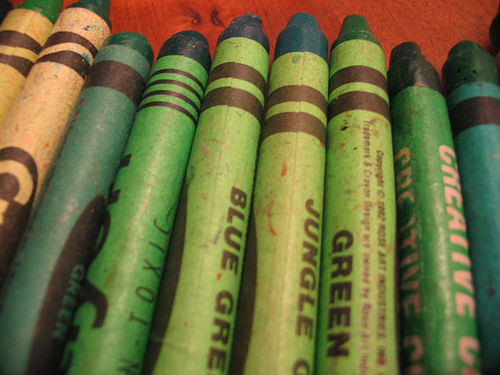
Creative Commons: Brandy Shaul
As I read through my various books on green housekeeping and personal care, and peruse green blogs and their comments, I’m often struck with how one persons green is another person’s toxin. There seems to be quite a spread of opinion on the subject of what’s actually “green”. I’ve decided there’s really no right or wrong in this, there’s simply different shades of green.
For example, let’s take laundry soap. When I first got married 12 years ago, I started with basic laundry soap in a big plastic bottle. I realized over the years that I really hated the smell, and wasn’t too fond of the dyes. I switched over to a free/clear option by the same company, and that kept me for several years, switching to the more concentrated versions in order to reduce plastic usage. Now that I’m deeper into detoxifying my life, I make my own laundry soap. Aside from being fantastically cheap to make, it’s considered “green” because I’m staying away from purchasing plastic bottles of laundry soap once a month, and staying away from parabens and other petrochemicals that pollute my clothing, my home, and the wastewater that comes from my washing machine. I currently use a powdered mix of washing soda, Borax, and castile soap.
You’d think that was pretty green, especially using castile soap instead of the petroleum based napthelene bar some recipes call for. The washing soda is made from plant ash, and is considered to be non-toxic in an environmental sense (it is not a suspected carcinogen and has been in use for hundreds of years) . However, it is very alkaline and moderately toxic if swallowed, and must be kept out of the reach of children. The Borax is considered safe for household use, but it’s close cousin boric acid is a known neurotoxin. It’s supposedly a great fungicide and an insecticide. It can actually be taken internally in small doses. There are some hazards to including borax in products for human usage, though in cleaning they seem to be negligable. While plants need a trace amount of the borax mineral, too much will kill them, so use of borax in a greywater system where laundry water is recycled in the garden should be avoided. Borax is already in use in most laundry products, and there have been no known issues with a buildup of borax in the environment (at least, not that I could find). This recipe is much better than the commercial products I was using, but may have a few flaws.
Deep green people will avoid the washing soda and the borox entirely. The deep-green choice is to use Soap Nuts. Soap nuts are a completely natural product. They grow on trees (they are a fruit closely related to the goji berry), and have a quantity of saponins (soap) in their shells. A kilo of soap nuts (which apparently does about 300-400 loads of laundry) can cost about $40, but prices vary. The two ways to use it is to drop the nuts in a muslin bag and toss them in with your laundry (which apparently doesn’t work well with cold water), or to steep a soap nut “tea” to extract the saponins and use that liquid in your laundry. While soap nuts have been used in asia for centuries and europe for a long time, I haven’t found any evidence of toxicity studies, however they are certainly less toxic than many other laundry cleaners. I think a test of soap nuts in my house is in order.
I think when we start out on the greening of our lives, it’s like a spring green of new young plants. We start out by realizing the true toxicity of a class of products in our house, and decide to try something better. We try a few “green” products (whether they really are green or just “greenwashed”) and try to find products that do the job but are a less toxic solution. At this point I think we move from spring green to a nice kelly green. The more we know, the more we find out, the better solutions we find. More and more toxins leave our home, we use more and more natural elements to clean. Which luckily doesn’t mean more and more products entering our home, as a box of baking soda and a jug of vinegar go a long way!
Emerald green, forest green, however green you want to go, how much you want to learn and how many products you want to replace is completely up to you. Going one more shade towards detoxifying your life is a reward for yourself and your family, and well worth the journey.
